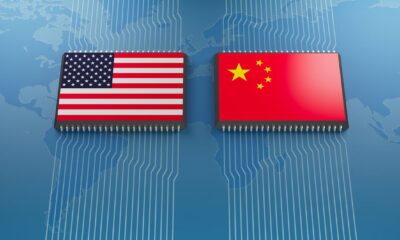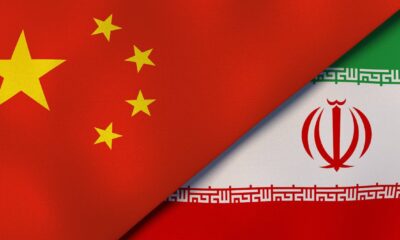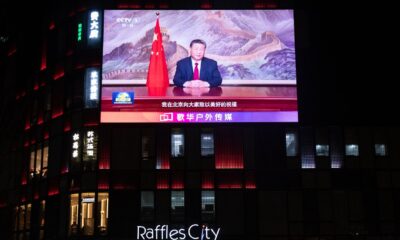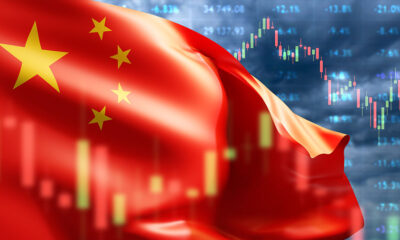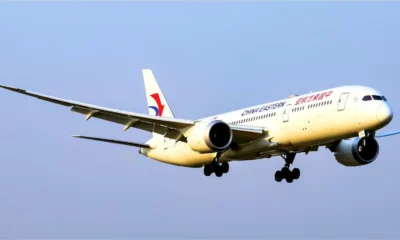China
With China seeking AI dominance, Taiwan’s efforts to slow neighbor’s access to advanced chips needs support from the West
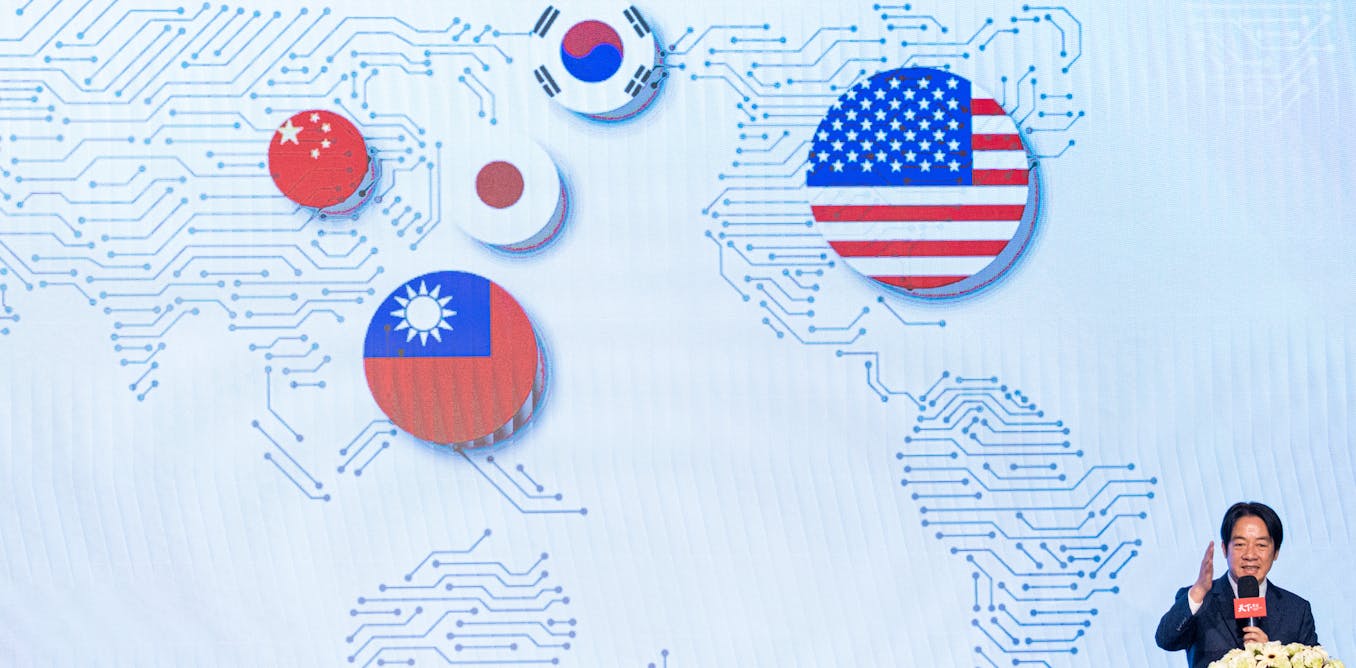
Tensions between China, Taiwan, and the U.S. focus on semiconductor supply chains, vital for technology and military. Taiwan aims to safeguard its chip dominance amidst geopolitical rivalries and regulatory challenges.
Tensions between China, Taiwan and the U.S. aren’t limited to aerial military maneuvers and drills on the high seas. The shadow conflict is also playing out in the technological arena.
One of the central drivers of the deepening geopolitical rifts between China on one side and Taiwan and the U.S. on the other is dominance over global semiconductor supply chains. This is because semiconductors – or microchips – power everything from smartphones and home office software to critical infrastructure and advanced military hardware.
As international demand for sophisticated microchips surges, not least owing to the blistering growth of artificial intelligence, so does their strategic value to the global economy and the progress of individual nations. China today spends as much importing microchips as it does importing oil.
This deepening reliance on semiconductors around the world adds another layer of complexity to simmering China-Taiwan tensions. Today, Taiwan is the world’s largest and most advanced microchip producer, and China is the planet’s biggest consumer of semiconductors.
As researchers in geopolitics and advanced technologies, we see the competition to control microchip supply chains as one of the defining struggles of the 21st century. Taiwan’s experience could serve as an example to the U.S., which on Sept. 6, 2024, announced a fresh wave of export controls on semiconductor goods.
The world’s chipmaker
Taiwan did not emerge as the world’s semiconductor powerhouse by accident. The self-governing island has been producing high-quality microchips for decades due in large part to its flexible production network and world-class engineering talent pool.
Yet Taiwan faces a delicate balancing act in maintaining its market superiority in semiconductors, especially when it comes to exporting advanced technologies to China. For one, Taiwanese policymakers are understandably determined to both avoid political entanglements with a country that views the island as its own territory and hold on to the island’s intellectual property. Moreover, Taiwan wants to keep microchips from powering Chinese missiles currently pointed at the capital, Taipei.
The road to regulating chips
Until the early 1990s, the transfer of technologies to China was prohibited under Taiwanese law. But regulations were weakly enforced. As a result, Taiwanese businesses frequently circumvented existing sanctions by rerouting investments through then-British Hong Kong. The reality was that the chip industry was a lucrative source of revenue for the island.
Taiwan’s approach to regulating the flow of technologies started to change in 1993 when President Lee Teng-hui implemented the “no haste, be patient” policy. The strict ban was relaxed and replaced by a system in which additional layers of oversight were added to highly advanced technologies, deals valued at more than US$50 million and specialized critical infrastructure projects.
Crafted over decades, this “outbound investment screening” system features multiple checks intended to safeguard Taiwan’s core chip technologies. Taiwanese authorities are actively involved in monitoring and overseeing investment decisions involving China made by the island’s semiconductor companies. Officials are also keen to ensure that local chipmakers are aligned with Taiwan’s strategic interests, while minimizing political ties with its neighbor.
During the screening process, Taiwanese companies are required to submit detailed investment plans to government-appointed reviewers for approval. For example, when a Taiwanese semiconductor firm, such as the world’s largest chip manufacturer TSMC, considers establishing a new facility in China, it must first undertake a rigorous approval process.
Changing calculations
While the cautious policy shift appears prescient today given rising geopolitical tensions, at the time it was considered out of step with the direction of more open global trade relations with China. The restrictive human rights considerations that had curbed Western trade with China were eased in the 1990s after intensive lobbying by U.S. corporations. In 2000, U.S. President Bill Clinton granted China permanent normal trade relations, paving the way for its accession to the World Trade Organization a year later. Trade with China, including of advanced technologies, exploded thereafter.
A visitor explores the TSMC exhibition at the World Semiconductor Congress 2022 in Nanjing, Jiangsu province, China.
CFOTO/Future Publishing via Getty Images
But Washington’s strategic calculations over trade with China have shifted dramatically over the past decade. In 2018, the U.S. singled out China as a strategic competitor, designating several Chinese hackers and the government itself as national security threats. By August 2023, President Joe Biden directed the Treasury Department to draft regulations to develop an outbound investment security program to safeguard semiconductor, quantum and AI technologies.
A few months later, the U.S. issued sweeping restrictions on the trade of advanced chips and chipmaking equipment with China. In early 2024, the European Union released a white paper proposing to do the same.
Of course, Taiwan has its own specific political concerns when it comes to China. Given Beijing’s long-standing ambition to, as Chinese leaders put it, “reunify” Taiwan with the mainland, local officials are particularly aware how doing business with China might have unpredictable and damaging political ramifications.
The Taiwanese National Security Bureau has long warned that Beijing is using business to covertly advance its political ambition, including by leveraging Taiwanese capital to build influence and proxies within Taiwan. And in late 2023, Taiwan’s National Science and Technology Council announced a list of over 20 core technologies it wanted to prevent Beijing from acquiring, including know-how and raw material to make chips smaller than 14 nanometers.
New challenges for Taiwan’s regulations
Taiwanese authorities and businesses have built on the outbound screening system in order to push back against Chinese influence. In recent years, additional principles to protect Taiwan’s semiconductor dominance have been introduced, including requiring Taiwanese investors to retain a controlling interest in all Chinese subsidiaries.
Nonetheless, Taiwan’s outbound investment screening system is facing multiple tests. While it is designed to curb the transfer of advanced Taiwanese technologies to China, it also has to oversee financial investments from Taiwan into China’s surging chipmaking sector.
In 2022, for example, the Taiwanese technology group Foxconn announced an investment in Tsinghua Unigroup through its Chinese subsidiary. Tsinghua Unigroup is backed by China’s National Integrated Circuit Industry Investment Fund and controlled by a Beijing-based private equity firm. Owing to Foxconn’s failure to submit a required preapproval application to the outbound investment screening authorities, the Taiwanese government imposed a fine on the company, which eventually withdrew its investment.
Inside the Taiwan Semiconductor Research Institute in Hsinchu, Taiwan.
Annabelle Chih/Getty Images
China’s growing chip industry is also expanding its local supply chain, raising questions about whether Taiwan should expand restrictions on other suppliers linked to semiconductor manufacturers. After the U.S. introduced export controls on China in late 2023, the Chinese firm Huawei aggressively expanded its chip production network by leveraging its affiliates and Taiwanese suppliers. Four Taiwanese semiconductor firms that had previously been approved for outbound investment were subsequently accused of aiding Huawei in building China’s domestic chip supply chain.
Confronting China’s ambition
With access to Taiwanese semiconductors increasingly restricted, China has aggressively pursued greater technological autonomy. It has done so by reducing its reliance on imports of advanced equipment and materials from U.S., Japan, the Netherlands and Taiwan.
There are legitimate concerns in the West that tightening international export restrictions on microchips and relevant suppliers could inadvertently strengthen China’s determination to accelerate the development of its domestic semiconductor production.
Official data appears to corroborate this view; China’s overall imports of microchips in 2023 were below 2017 levels. Exports of Taiwanese chips to China dropped by 18% in 2023.
Meanwhile, China’s National Bureau of Statistics reported that overall domestic chip production grew by 40% in the first quarter of 2024. Its share of global capacity to produce logic chips at 10-22 nanometers could rise from 6% to 19% by 2032.
But these data points do not necessarily mean that China is close to technological autonomy. Most of the increases in domestic chip production involve “mature” chips for household appliances and electric vehicles, rather than the most advanced chips required to accelerate AI computing power.
Meanwhile, China is still dependent on Taiwan for its semiconductors. The decrease in overall chip imports could be a result of international export restrictions on the most cutting-edge semiconductors needed for high-end smartphones and other AI-driven, high-performance computing products.
Coordinating international efforts
Restricting China’s access to the global superconductor supply chain is challenging. While doing so makes China reliant on Taiwanese chips – and as such may serve as a temporary protective shield against invasion – it could also exacerbate Beijing’s insecurities, pushing President Xi Jinping to hasten efforts to become technologically self-sufficient in advanced chips manufacturing. At the same time, outright bans on these chips hasn’t prevented China from producing a range of semiconductors using foreign capital and technology.
To address this challenge, Taiwan’s screening mechanisms not only need to remain nimble and vigilant – they need to be supported by a coordinated international approach. Only then will it be possible to slow the progress of authoritarian regimes in the AI race.
This article is republished from The Conversation under a Creative Commons license. Read the original article.
Business
China Limits Apple Operations as BYD Manufacturing Moves to India and Southeast Asia Amid Trade Frictions | International Business News – The Times of India

China is restricting the export of high-tech manufacturing equipment and personnel to India and Southeast Asia, aiming to maintain domestic production amid potential US tariffs, impacting companies like Foxconn and BYD.
China Curbs on High-Tech Manufacturing
China is intensifying restrictions on the movement of employees and specialized equipment essential for high-tech manufacturing in India and Southeast Asia. This measure aims to prevent companies from relocating production due to potential tariffs under the incoming US administration. Beijing has urged local governments to restrict technology transfers and export of manufacturing tools as part of this strategy.
Impact on Foxconn and Apple’s Strategy
Foxconn, Apple’s primary assembly partner, is facing challenges in sending staff and receiving equipment in India, which could impact production. Despite these hurdles, current manufacturing operations remain unaffected. The Chinese government insists it treats all nations equally while reinforcing its domestic production to mitigate job losses and retain foreign investments.
Broader Implications for India
Additionally, these restrictions affect electric vehicle and solar panel manufacturers in India, notably BYD and Waaree Energies. Although the measures are not explicitly targeting India, they complicate the business landscape. As foreign companies seek alternatives to China, these developments are likely to reshape manufacturing strategies amidst ongoing geopolitical tensions.
China
China’s GDP Grows 5% in 2024: Key Insights and Main Factors
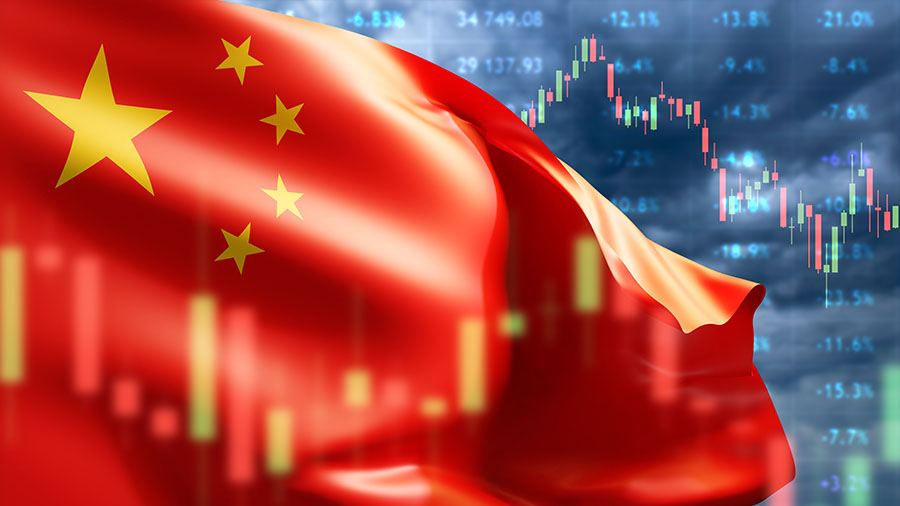
In 2024, China’s GDP grew by 5.0%, meeting its annual target. The fourth quarter saw a 5.4% increase, driven by exports and stimulus measures. The secondary industry grew 5.3%, while the tertiary increased by 5.0%, totaling RMB 134.91 trillion.
China’s GDP grew by 5.0 percent in in 2024, meeting the government’s annual economic target set at the beginning of the year. Fourth-quarter GDP exceeded expectations, rising by 5.4 percent, driven by exports and a flurry of stimulus measures. This article provides a brief overview of the key statistics and the main drivers behind this growth.
According to official data released by the National Bureau of Statistics (NBS) on January 17, 2025, China’s GDP reached RMB 134.91 trillion (US$18.80 trillion) in 2024, reflecting a 5.0 percent year-on-year growth at constant prices. During the 2024 Two Sessions, the government set the 2024 GDP growth target of “around 5 percent”.
By sector, the secondary industry expanded by 5.3 percent year-on-year to RMB 49.21 trillion (US$6.85 trillion), the fastest among the three sectors, while the tertiary industry grew by 5.0 percent, reaching RMB 76.56 trillion (US$10.63 trillion) and the primary industry contributed RMB 9.14 trillion (US$1.31 trillion), growing 3.5 percent.
A more detailed analysis of China’s economic performance in 2024 will be provided later.
(1USD = 7.1785 RMB)
| This article was first published by China Briefing , which is produced by Dezan Shira & Associates. The firm assists foreign investors throughout Asia from offices across the world, including in in China, Hong Kong, Vietnam, Singapore, and India . Readers may write to info@dezshira.com for more support. |
Read the rest of the original article.
China
Can science be both open and secure? Nations grapple with tightening research security as China’s dominance grows

The U.S.-China science agreement renewal narrows collaboration scopes amid security concerns, highlighting tensions. Nations fear espionage, hindering vital international partnerships essential for scientific progress. Openness risks declining.
Amid heightened tensions between the United States and China, the two countries signed a bilateral science and technology agreement on Dec. 13, 2024. The event was billed as a “renewal” of a 45-year-old pact to encourage cooperation, but that may be misleading.
The revised agreement drastically narrows the scope of the original agreement, limits the topics allowed to be jointly studied, closes opportunities for collaboration and inserts a new dispute resolution mechanism.
This shift is in line with growing global concern about research security. Governments are worried about international rivals gaining military or trade advantages or security secrets via cross-border scientific collaborations.
The European Union, Canada, Japan and the United States unveiled sweeping new measures within months of each other to protect sensitive research from foreign interference. But there’s a catch: Too much security could strangle the international collaboration that drives scientific progress.
As a policy analyst and public affairs professor, I research international collaboration in science and technology and its implications for public and foreign policy. I have tracked the increasingly close relationship in science and technology between the U.S. and China. The relationship evolved from one of knowledge transfer to genuine collaboration and competition.
Now, as security provisions change this formerly open relationship, a crucial question emerges: Can nations tighten research security without undermining the very openness that makes science work?
Chinese Premier Deng Xiaoping and American President Jimmy Carter sign the original agreement on cooperation in science and technology in 1979.
Dirck Halstead/Hulton Archive via Getty Images
China’s ascent changes the global landscape
China’s rise in scientific publishing marks a dramatic shift in global research. In 1980, Chinese authors produced less than 2% of research articles included in the Web of Science, a curated database of scholarly output. By my count, they claimed 25% of Web of Science articles by 2023, overtaking the United States and ending its 75-year reign at the top, which had begun in 1948 when it surpassed the United Kingdom.
In 1980, China had no patented inventions. By 2022, Chinese companies led in U.S. patents issued to foreign companies, receiving 40,000 patents compared with fewer than 2,000 for U.K. companies. In the many advanced fields of science and technology, China is at the world frontier, if not in the lead.
Since 2013, China has been the top collaborator in science with the United States. Thousands of Chinese students and scholars have conducted joint research with U.S. counterparts.
Most American policymakers who championed the signing of the 1979 bilateral agreement thought science would liberalize China. Instead, China has used technology to shore up autocratic controls and to build a strong military with an eye toward regional power and global influence.
Leadership in science and technology wins wars and builds successful economies. China’s growing strength, backed by a state-controlled government, is shifting global power. Unlike open societies where research is public and shared, China often keeps its researchers’ work secret while also taking Western technology through hacking, forced technology transfers and industrial espionage. These practices are why many governments are now implementing strict security measures.
Nations respond
The FBI claims China has stolen sensitive technologies and research data to build up its defense capabilities. The China Initiative under the Trump administration sought to root out thieves and spies. The Biden administration did not let up the pressure. The 2022 Chips and Science Act requires the National Science Foundation to establish SECURE – a center to aid universities and small businesses in helping the research community make security-informed decisions. I am working with SECURE to evaluate the effectiveness of its mission.
Other advanced nations are on alert, too. The European Union is advising member states to boost security measures. Japan joined the United States in unveiling sweeping new measures to protect sensitive research from foreign interference and exploitation. European nations increasingly talk about technological sovereignty as a way to protect against exploitation by China. Similarly, Asian nations are wary of China’s intentions when it seeks to cooperate.
Australia has been especially vocal about the threat posed by China’s rise, but others, too, have issued warnings. The Netherlands issued a policy for secure international collaboration. Sweden raised the alarm after a study showed how spies had exploited its universities.
Canada has created the Research Security Centre for public safety and, like the U.S., has established regionally dispersed advisers to provide direct support to universities and researchers. Canada now requires mandatory risk assessment for research partnerships involving sensitive technologies. Similar approaches are underway in Australia and the U.K.
Germany’s 2023 provisions establish compliance units and ethics committees to oversee security-relevant research. They are tasked with advising researchers, mediating disputes and evaluating the ethical and security implications of research projects. The committees emphasize implementing safeguards, controlling access to sensitive data and assessing potential misuse.
Japan’s 2021 policy requires researchers to disclose and regularly update information regarding their affiliations, funding sources – both domestic and international – and potential conflicts of interest. A cross-ministerial R&D management system is unrolling seminars and briefings to educate researchers and institutions on emerging risks and best practices for maintaining research security.
The Organisation for Economic Co-operation and Development keeps a running database with more than 206 research security policy statements issued since 2022.
Emmanuelle Charpentier, left, from France, and Jennifer Doudna, from the U.S., shared the Nobel Prize in chemistry in 2020 for their joint research.
Miguel RiopaI/AFP via Getty Images
Openness waning
Emphasis on security can strangle the international collaboration that drives scientific progress. As much as 25% of all U.S. scientific articles result from international collaboration. Evidence shows that international engagement and openness produce higher-impact research. The most elite scientists work across national borders.
Even more critically, science depends on the free flow of ideas and talent across borders. After the Cold War, scientific advancement accelerated as borders opened. While national research output remained flat in recent years, international collaborations showed significant growth, revealing science’s increasingly global nature.
The challenge for research institutions will be implementing these new requirements without creating a climate of suspicion or isolation. Retrenchment to national borders could slow progress. Some degree of risk is inherent in scientific openness, but we may be coming to the end of a global, collaborative era in science.
This article is republished from The Conversation under a Creative Commons license. Read the original article.


